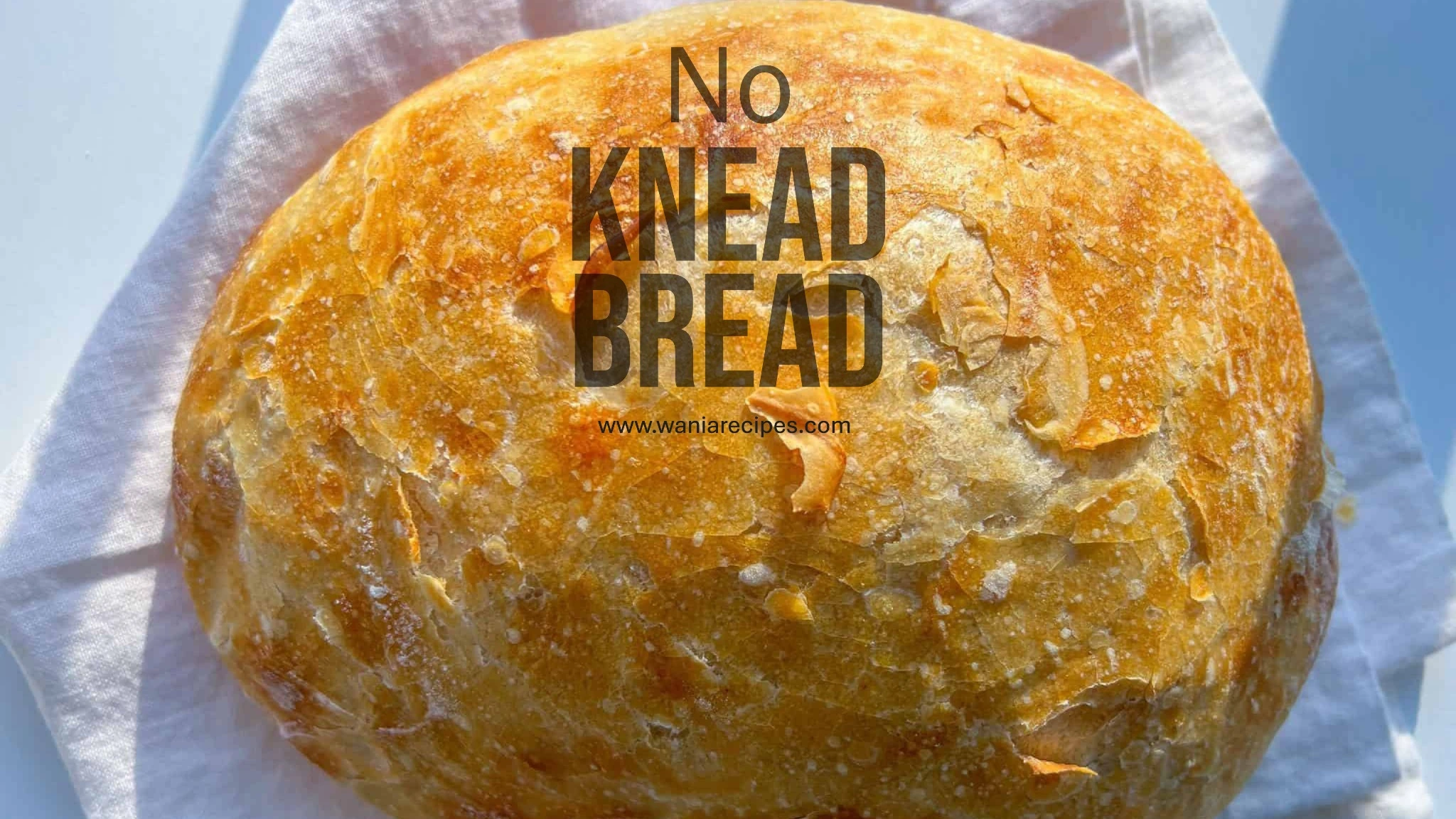There’s nothing quite like the smell of freshly baked bread wafting through your home. That warm, yeasty, utterly comforting aroma that promises a slice of heaven. But if you’ve ever been intimidated by the thought of baking your own—all that precise kneading, worrying about over-working the gluten, the fear of a dense, brick-like loaf—I have glorious news for you. This No Knead Bread is your gateway to bakery-quality results with shockingly little effort. It’s crusty on the outside, soft and airy on the inside, and so simple it feels like magic. The secret? Time does all the work for you. While my classic sandwich bread recipe is a beloved staple, this method is for those days when you want incredible bread with almost no hands-on time. Get ready to fall in love with baking all over again.
Table of Contents
What is No Knead Bread?
So, what in the world is “No Knead Bread”? It sounds too good to be true, right? Is it some kind of kitchen wizardry or a lazy baker’s dream come true? Well, it’s a little bit of both! The name means exactly what it says: you literally do not knead the dough. Not for five minutes, not for one minute—not at all! Instead of building gluten strength through physical effort, this revolutionary (yet ancient) method uses a very wet dough and a long, slow fermentation time. The gluten develops all on its own while you’re off living your life. They say the way to a man’s heart is through his stomach, but I say the way to everyone’s heart is with a warm slice of homemade bread that didn’t require a workout to make. See for yourself how effortless it truly is!
Why You’ll Love This No Knead Bread
You are going to be absolutely smitten with this bread, and it’s not just because of its gorgeous, crackly crust. First, the main highlight is the breathtaking simplicity. With just four basic ingredients and zero special equipment, you can create a loaf that rivals any artisan bakery. It’s the perfect project for a beginner but so satisfying that experienced bakers return to it again and again.
Second, let’s talk cost. A loaf of similar artisan bread from a store can easily set you back five or seven dollars. This homemade version costs pennies per loaf, saving you a significant amount of money while giving you complete control over the ingredients. No mysterious preservatives, just pure, wholesome goodness.
Finally, the flavor and texture are unparalleled. The long, slow rise develops a subtle, slightly tangy complexity that you just can’t get from a quick-rise recipe. The crust shatters delightfully with every bite, giving way to a soft, chewy, and beautifully open crumb inside. It’s the ideal canvas for everything from a slather of creamy butter to a drizzle of high-quality olive oil. If you enjoy the hands-on process of my Sourdough Bread, you’ll appreciate this as a fantastic, low-maintenance alternative. Ready to make your kitchen smell incredible? Let’s get baking!
How to Make No Knead Bread
Quick Overview
This recipe is the epitome of easy, set-it-and-forget-it baking. The active preparation time is just 10 minutes, but the secret to its incredible flavor and texture is a patient 12-18 hour rest. The result is a stunning, rustic loaf with a crisp, golden crust and a soft, airy interior that is deeply satisfying to make and eat.
Key Ingredients for No Knead Bread
- 3 cups (360g) All-Purpose Flour
- 1 ½ teaspoons (7g) Kosher Salt
- ½ teaspoon (2g) Instant Yeast (or Active Dry Yeast)
- 1 ½ cups (350g) Warm Water
Step-by-Step Instructions
- Mix the Dough: In a large mixing bowl, whisk together the flour, salt, and instant yeast. Pour in the warm water and use a wooden spoon or your hands to mix until a shaggy, sticky dough forms. There should be no dry spots of flour. This will take less than a minute.
- The Long Rise: Cover the bowl tightly with plastic wrap or a lid. Let it rest at room temperature (about 70°F) for 12 to 18 hours. The dough will look bubbly, jiggly, and doubled in size.
- Shape the Loaf: Generously flour a work surface and your hands. The dough will be very sticky. Gently scrape the dough out onto the surface. With floured hands, fold the edges of the dough towards the center about 4-8 times, creating a rough ball shape.
- Second Rise: Place a sheet of parchment paper on a plate or a small baking sheet and generously dust it with flour or cornmeal. Place the shaped dough, seam-side down, onto the parchment. Cover it loosely with a clean kitchen towel and let it rise for another 1-2 hours, until it looks puffy.
- Preheat the Pot: About 30 minutes before the second rise is finished, place your Dutch oven (with the lid on) into your regular oven. Preheat the oven to 450°F (230°C). It is crucial that the pot is scorching hot.
- Bake: Carefully remove the hot Dutch oven. Using the parchment paper as a sling, lift the dough and gently lower it into the hot pot. Score the top of the dough about ½-inch deep with a sharp knife or razor blade. Cover with the lid and bake for 30 minutes.
- Crisp the Crust: After 30 minutes, remove the lid. The bread will be pale but well-risen. Continue baking, uncovered, for another 15-20 minutes until the crust is a deep, golden brown and beautiful.
- Cool: Carefully remove the bread from the Dutch oven and place it on a wire rack. This is the hardest part: you must let the bread cool completely for at least one hour before slicing. This allows the interior crumb to set properly.
What to Serve No Knead Bread With
This bread is an incredibly versatile companion to any meal! Tear into it warm (after cooling!) with a dish of high-quality olive oil and balsamic vinegar for dipping. It’s sublime for sopping up the sauces from a cozy Beef Stew or a hearty Pasta Bolognese. For a simple, elegant appetizer, top slices with ripe tomato, fresh basil, and a sprinkle of salt. Of course, it also makes the ultimate grilled cheese sandwich or is perfect simply slathered with a thick layer of butter and a pinch of flaky sea salt.
Top Tips for Perfecting No Knead Bread
- Don’t Fear the Wet Dough: The high hydration (wetness) of this dough is what creates those beautiful, irregular holes in the crumb. It will be sticky and seem too wet, but trust the process.
- Score with Confidence: Don’t skip scoring the top of the loaf right before baking. This controlled cut allows the steam to escape and lets the bread expand beautifully in the oven instead of bursting at the seams.
- Create Steam without a Dutch Oven: If you don’t have a Dutch oven, you can create a steamy environment by placing a shallow metal pan on the bottom rack of the oven while it preheats. When you put the bread in, carefully toss a few ice cubes into the hot pan.
- Experiment with Flours: Feel free to substitute up to 1 cup of the all-purpose flour with whole wheat or rye flour for a different flavor and texture profile.
Storing and Reheating Tips
To maintain that perfect crackly crust, store the completely cooled bread at room temperature, cut-side down on a cutting board, for up to 2 days. For longer storage, wrap the loaf tightly in plastic wrap and then in foil before freezing for up to 3 months.
To reheat, place frozen or room-temperature bread directly into a 350°F (175°C) oven for 10-15 minutes until warm and crisp. For a single slice, toasting is the best way to bring back its magic. Avoid storing bread in the fridge, as it accelerates staling.
For More Recipes Visit!: www.waniarecipes.com

